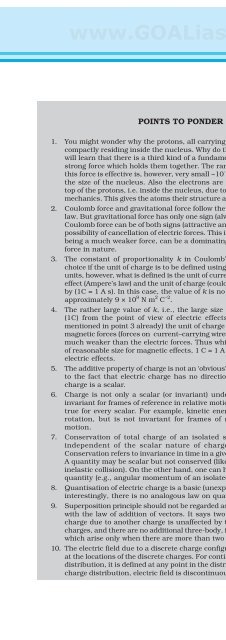com www.GOALias.blogspot.com
com www.GOALias.blogspot.com
com www.GOALias.blogspot.com
- No tags were found...
You also want an ePaper? Increase the reach of your titles
YUMPU automatically turns print PDFs into web optimized ePapers that Google loves.
<strong>www</strong>.<strong>GOALias</strong>.<strong>blogspot</strong>.<strong>com</strong>Electric Chargesand FieldsPOINTS TO PONDER1. You might wonder why the protons, all carrying positive charges, are<strong>com</strong>pactly residing inside the nucleus. Why do they not fly away? Youwill learn that there is a third kind of a fundamental force, called thestrong force which holds them together. The range of distance wherethis force is effective is, however, very small ~10 -14 m. This is preciselythe size of the nucleus. Also the electrons are not allowed to sit ontop of the protons, i.e. inside the nucleus, due to the laws of quantummechanics. This gives the atoms their structure as they exist in nature.2. Coulomb force and gravitational force follow the same inverse-squarelaw. But gravitational force has only one sign (always attractive), whileCoulomb force can be of both signs (attractive and repulsive), allowingpossibility of cancellation of electric forces. This is how gravity, despitebeing a much weaker force, can be a dominating and more pervasiveforce in nature.3. The constant of proportionality k in Coulomb’s law is a matter ofchoice if the unit of charge is to be defined using Coulomb’s law. In SIunits, however, what is defined is the unit of current (A) via its magneticeffect (Ampere’s law) and the unit of charge (coulomb) is simply definedby (1C = 1 A s). In this case, the value of k is no longer arbitrary; it isapproximately 9 × 10 9 N m 2 C –2 .4. The rather large value of k, i.e., the large size of the unit of charge(1C) from the point of view of electric effects arises because (asmentioned in point 3 already) the unit of charge is defined in terms ofmagnetic forces (forces on current–carrying wires) which are generallymuch weaker than the electric forces. Thus while 1 ampere is a unitof reasonable size for magnetic effects, 1 C = 1 A s, is too big a unit forelectric effects.5. The additive property of charge is not an ‘obvious’ property. It is relatedto the fact that electric charge has no direction associated with it;charge is a scalar.6. Charge is not only a scalar (or invariant) under rotation; it is alsoinvariant for frames of reference in relative motion. This is not alwaystrue for every scalar. For example, kinetic energy is a scalar underrotation, but is not invariant for frames of reference in relativemotion.7. Conservation of total charge of an isolated system is a propertyindependent of the scalar nature of charge noted in point 6.Conservation refers to invariance in time in a given frame of reference.A quantity may be scalar but not conserved (like kinetic energy in aninelastic collision). On the other hand, one can have conserved vectorquantity (e.g., angular momentum of an isolated system).8. Quantisation of electric charge is a basic (unexplained) law of nature;interestingly, there is no analogous law on quantisation of mass.9. Superposition principle should not be regarded as ‘obvious’, or equatedwith the law of addition of vectors. It says two things: force on onecharge due to another charge is unaffected by the presence of othercharges, and there are no additional three-body, four-body, etc., forceswhich arise only when there are more than two charges.10. The electric field due to a discrete charge configuration is not definedat the locations of the discrete charges. For continuous volume chargedistribution, it is defined at any point in the distribution. For a surfacecharge distribution, electric field is discontinuous across the surface.45
















